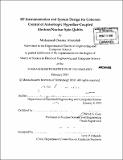| dc.contributor.advisor | David G. Cory. | en_US |
| dc.contributor.author | Abutaleb, Mohamed Osama | en_US |
| dc.contributor.other | Massachusetts Institute of Technology. Dept. of Electrical Engineering and Computer Science. | en_US |
| dc.date.accessioned | 2010-08-31T14:35:43Z | |
| dc.date.available | 2010-08-31T14:35:43Z | |
| dc.date.copyright | 2010 | en_US |
| dc.date.issued | 2010 | en_US |
| dc.identifier.uri | http://hdl.handle.net/1721.1/57778 | |
| dc.description | Thesis (S.M.)--Massachusetts Institute of Technology, Dept. of Electrical Engineering and Computer Science, 2010. | en_US |
| dc.description | Cataloged from PDF version of thesis. | en_US |
| dc.description | Includes bibliographical references (p. 81-85). | en_US |
| dc.description.abstract | Coherent control is a fundamental challenge in quantum information processing (QIP). Our system of interest employs a local, isolated electron spin to coherently control nuclear spins. Coupled electron/nuclear spins are a promising candidate for QIP: nuclear spins are used for information storage and computation due to their long coherence times, while the electron is used as a spin actuator for initialization, information transfer, control, and readout. This is the first implementation of a local processor using the central qubit architecture. In this work, a robust integrated system for coherent control of these spins is proposed. The system includes a mechanical and cryogenic system for sample handling, cooling, and suspension; computer software for experimental control and optimal control pulse determination; and a custom-designed pulsed electron spin resonance (ESR) spectrometer with digital signal acquisition and processing. The spectrometer enhances and expands past contributions of J. S. Hodges and J. C. Yang, who built a first generation device capable of amplitude modulated control pulses. The new device features improved noise properties, higher power, better carrier and sideband rejection, and a more customizable analysis via digital signal processing. It also implements both amplitude and phase modulation of control pulses. Further, it introduces the ability to address different resonances in the spin system by switching intermediate frequencies while maintaining phase coherence. Our work concludes with a signal-to-noise ratio (SNR) analysis that demonstrates improvement of more than a factor of 15 compared to the earlier device. | en_US |
| dc.description.statementofresponsibility | by Mohamed Osama Abutaleb. | en_US |
| dc.format.extent | 85 p. | en_US |
| dc.language.iso | eng | en_US |
| dc.publisher | Massachusetts Institute of Technology | en_US |
| dc.rights | M.I.T. theses are protected by
copyright. They may be viewed from this source for any purpose, but
reproduction or distribution in any format is prohibited without written
permission. See provided URL for inquiries about permission. | en_US |
| dc.rights.uri | http://dspace.mit.edu/handle/1721.1/7582 | en_US |
| dc.subject | Electrical Engineering and Computer Science. | en_US |
| dc.title | RF instrumentation and system design for coherent control of anisotropic hyperfine-coupled electron/nuclear spin qubits | en_US |
| dc.type | Thesis | en_US |
| dc.description.degree | S.M. | en_US |
| dc.contributor.department | Massachusetts Institute of Technology. Department of Electrical Engineering and Computer Science | |
| dc.identifier.oclc | 635536428 | en_US |
